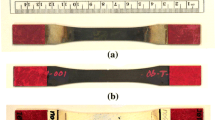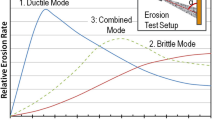Abstract
The performance of a coated silicon carbide/carbon composite under isothermal and thermal fatigue conditions was investigated. The material studied is known as Ceracarb™ which consists of eight-harness satin weave Nicalon® silicon carbide cloth reinforcement, a carbonaceous matrix, and a silicon carbide composite coating. This advanced composite is being considered for replacing the nickel based superalloy Rene'41, as the exhaust nozzle components on military afterburning turbine engines. Thermal fatigue experiments, performed in the laboratory using a thermal cycling test system, were intended to roughly simulate the thermal excursions of an afterburning exhaust nozzle. Several thermal profiles were used to characterize the role of temperature, number of cycles, temperature range, and time at temperature, on the room temperature residual tensile strength of the material. The same thermal profiles were also conducted on test specimens of Rene'41 in order to compare its durability in the laboratory simulation test set-up to the composite. Both materials showed no loss in strength from the as-received condition following thermal testing. However, the Rene'41 showed evidence of microstructural instability at the maximum test temperature of 1093°C (2000°F) which did affect the toughness of the material. While the results from this study showed that both materials retained strength when thermally exposed in the laboratory under no loads, thermal testing under load may provide a more realistic view of how the materials perform in the afterburning exhaust nozzle application.
Similar content being viewed by others
References
D. M. Dawson, in “High Performance Materials in Aerospace,” edited by H. M. Flower (Chapman & Hall, London, 1995) p. 183.
R. Lehman, in “Structural Ceramics-Treatise on Material Science and Technology,” edited by J. B. Watchman (Academic Press Inc., Boston, 1989) p. 229.
R. N. Katz, in “Structural Ceramics-Treatise on Material Science and Technology,” edited by J. B. Watchman (Academic Press Inc., Boston, 1989) p. 10.
L. P. Zawadaand S. S. Lee, Presented at Advance Research Projects Agency Ceramic Insertion Program Annual Review, (Annapolis, 1994).
L. P. Zawada, Presented at Advanced Research Projects Agency Ceramic Insertion Program Review, (Annapolis, 1997).
K. K. Chawla, “Ceramic Matrix Composites” (Chapman and Hall, New York, 1993).
T. Araki, T. Natumura, M. Hayashi, S. Sugai, et al., in Proceedings of the 4th Japan International SAMPE Symposium,(Japan, 1995) p. 374.
P. Spriet, D. Boury and G. Habarou, in “High Temperature Ceramic-Matrix Composites I: Design, Durability, and Performance, edited by A. G. Evans and R. Naslain” (American Ceramic Society, Westerville, 1995) p. 191.
P. Spriet and G. Habarou, in Proceedings of the 1st International Conference on Ceramic and Metal Matrix Composites, CMMC'96 Part 2 (of 2), (Spain, 1996) p. 1267.
L. Heraund, in Proceedings of the Verbundwerk (1990) p. 25.21.
A. K. Gopalan, J. A. Manteiga and J. C. Mayer, in The Leading Edge, Winter, 12–15.
http://www.cnn.com/US/9904/27/F16.crash (1999).
Armed Forces Journal International (1996) 20.
“Superalloys: A Technical Guide” edited by E. F. Bradley (ASM International, Metals Park, 1988) p. 163.
Metals Handbook, “Properties and Selection: Stainless Steels, Tool Materials, and Special Purpose Metals” vol. 3 (ASM International, Metals Park, 1980) p. 208.
C. T. Sims, N. S. Stoloff and W. C. Hagel, “Superalloys II-High Temperature Materials for Aerospace and Industrial Power” (John Wiley and Sons, New York, 1987) p. 591, 598, 604.
M. Huger, S. Souchard and C. Gault, J. Mater. Sci. Let. (1993) 414.
R. Naslain, in Proceedings of the Second International Con-ference on High-Temperature Ceramic-Matrix Composites II: Manufacturing and Materials Development, edited by A. G. Evans and R. Naslain (The American Ceramic Society, Santa Barbara, 1995) p. 23.
G. N. Morscher, D. Bryant and R. E. Tressler,in Proceedings of edited
J. D. Cawley, A. J. Eckel and T. A. Parthasarathy, in Proceedings of edited
A. E. Evans, F. W. Zok and R. M. Mcmeeking,J. Am. Ceram. Soc. (1996) 2345.
S. C. Schwartz, S. Lee and P. V. Mosher, in “Damage and Oxidation Protection in High Temperature Composites” (American Society of Mechanical Engineers, New York, 1991) p. 23
X. Bourrat, K. S. Turner and A. E. Evans, J. Am. Ceram. Soc. (1995) 3050.
ASTM Subcommittee C28.07 on Ceramic Matrix Composites, (Philadelphia, 1994).
E. Lara-curzio, M. K. Ferber, R. Boisvert and A. Szweda, in Proceedings of the 19th Annual Conference on Composites, Advanced Ceramics, Materials, and Structures-B, (American Ceramic Society, Cocoa Beach, 1995) 341.
S. S. Lee, L. P. Zawada, R. Hay and C. Folsom, J. Am. Ceram. Soc. (1998) in press.
Author information
Authors and Affiliations
Rights and permissions
About this article
Cite this article
Pierce, J.L., Zawada, L.P. & Srinivasan, R. Tensile behavior of SiC/C and Rene'41 following isothermal exposure and thermal fatigue. Journal of Materials Science 35, 2973–2984 (2000). https://doi.org/10.1023/A:1004778726935
Issue Date:
DOI: https://doi.org/10.1023/A:1004778726935




